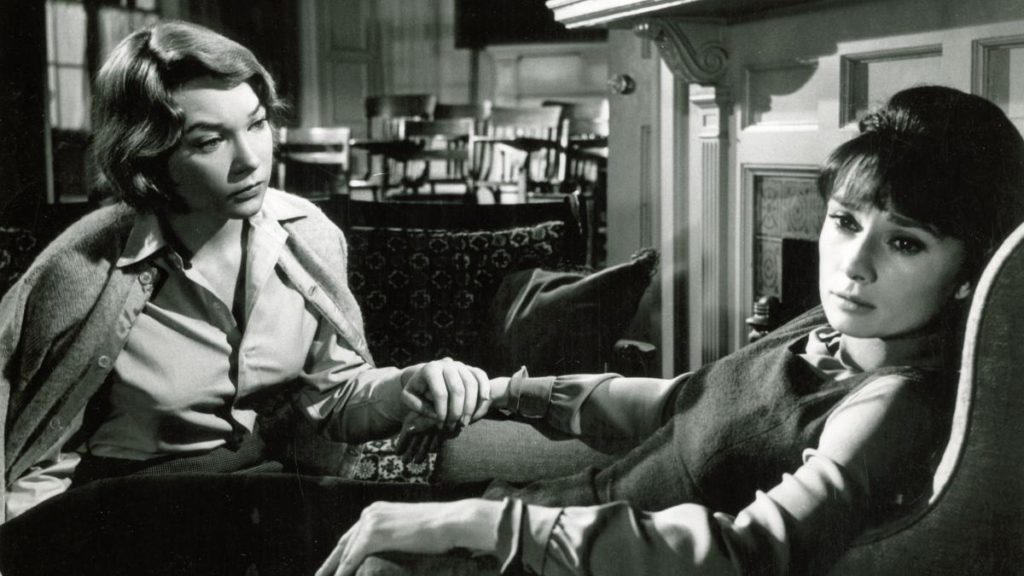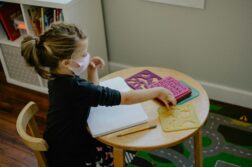
In 1961, a film version of Lillian Hellman’s play The Children’s Hour was produced under the same title. Unlike its 1936 cinematic predecessor—which sidestepped the lesbian crux of the story to comply with restrictive Hollywood decency codes of the time—the recent version was faithful to the original Broadway drama’s storyline, that of two schoolteachers whose livelihood is ruined when a malicious student spreads gossip about their relationship being indecent.
The twist happens when one of the pair, Martha, reveals that she does have romantic feelings for her colleague, Karen, who is happily engaged to a local doctor. From there, the twisted love-triangle becomes progressively more tragic for all three.
Starring Shirley MacLaine as Martha, Audrey Hepburn as Karen, and James Garner as Joe (Karen’s fiancé), the film is richly crafted, and compellingly acted. It manifests the terrifying moral that lies have the power to destroy. It’s a great lesson illustrated by an unforgettable story, but like any great lesson, it has deeper levels of meaning.
As a straight woman, I was most profoundly impacted by Martha’s disgust with her attraction to Karen.
“I feel so damn sick and dirty, I can’t stand it anymore,” she screams to the shocked Karen in a hysterical confession of love.
The scene echoes Oedipus Rex in that Martha’s freeing realization of her identity is accompanied by personal devastation: what she thinks, what she feels—what she is—is loathsome. Her self-hatred is utterly wrenching to watch, and the first time I saw it, it made me consider the pain involved in acknowledging one’s own non-heterosexual orientation, something I had never really considered.
I faced only the merest shade of a vaguely similar pain back when I was a young married woman who was openly and voluntarily childless. There was a host of bitter condemnation from my then-husband’s family, many of whom told me to my face that I was going to hell. The word “unnatural” was often thrown at me (ironically, the same word thrown at Martha in the film by her aunt) and I was accused of being a child-hater, which isn’t even true. But the unkindness wasn’t limited to my in-laws. During a routine physical, a nurse (noting my lack of reproductive history) asked why I hadn’t yet become a parent. I simply told her I wasn’t interested in raising a family, to which she snapped, “What’s wrong with you? What kind of person decides not to have children?” I remember once going into a bookstore to find material on the subject of voluntary childlessness in women, and inquiring at the counter for assistance in locating the proper section. Without missing a beat, the clerk said, “That’ll be in Abnormal Psychology.”
These experiences gave me a chilling insight into the kind of raw hatred that seemingly “nice” people can feel towards those whose lives are (in their estimation) inappropriate. It was a feeling of being shunned by the tribe, and worse—of being someone whose choices were interpreted by my fellow humans as an act of personal disrespect, as if I’d stepped up and spat violently on them instead of mildly answering their (rude) inquiries about my prospects for motherhood.
However, it didn’t make me feel sick or dirty, but simply shocked, and staggeringly disappointed at the painful things that were said to me. It made me remember “The Children’s Hour,” and it saddened me to have witnessed the same kind of cruelty in real life that the film depicted.
Later on in my life, I rented a huge Victorian house on a major street in a large city. Since I had a lovely front porch, I spent a lot of time sitting there, both day and night, watching the world go by. Passing couples were a common sight, whether elderly or young, and they very often held hands.
Under the cover of darkness, I would also see same-sex couples happily holding hands . . . until they sensed my presence, at which point, they would quickly drop their arms and walk along as though they didn’t know each other; as if they just happened to be walking side by side along the same street and were surprised to be in one another’s company.
In daytime, there were other same-sex couples who didn’t actually hold hands, but it was impossible not to see the evidence of connection between them: the odd palm would brush across a shoulder, or one would turn to give a telling glance to the other. I’m fully aware that many same-sex people strolling down the street were simply friends, but there was an innate awareness, at least where certain couples were concerned, that they were more than acquaintances traveling to a shared destination.
It was heartbreaking to know that some people didn’t feel safe or comfortable walking with their hands joined when that was a privilege I had never even questioned having. But again, reflecting on the film, I conceded that there were facets of non-heterosexual orientation the anguish of which I could not possibly fathom.
Gay people grapple daily with problems which straight people can’t imagine, and yet some of those straight people feel entitled to criticize and condemn. When I watched gay couples drop hands as they passed my house for fear I would think badly of their behavior, I was forced to ask myself what sort of society we’ve created for ourselves when spontaneous displays of affection are looked upon with disgust. Isn’t it possible that love is just that: love?
Maybe the most distasteful aspect of The Children’s Hour is that a child is the catalyst of all the protagonists’ misery; a spoiled, bullyish, vengeful child. A student at the girls’ school run by Martha and Karen, bristling from a reprimand, decides to retaliate by spreading a rumor about the pair being lovers. I’m not sure whether I’m more disturbed by her decision to do such a thing, or by her knowledge that doing such a thing will conjure a storm of disapproval against the two by all the adults in her midst.
It’s been more than 30 years since I first watched the film, and I’ve experienced a lot in life since then, yet at every new watching, I’m struck again by the feeling that there is a world of suffering I will never understand and which should not exist. Put another way, all these years later, such suffering is still a blessed mystery to me. “The Children’s Hour” remains simply a keyhole into a room to which I have no access. It awakened me to the reality of what it is to be gay in a hostile society—at least a small glimpse of it.
Even that glimpse, though, is more than enough. As Martha cries to Karen during her declaration of love, “You’re afraid of hearing it, but I’m more afraid than you.”
I’ll never know how many Marthas or Karens are out there, wracked with self-condemnation or being tormented for their sexual orientation/identity.
The Children’s Hour was the first film that made me wonder if perhaps the definition of love could be even greater than I imagined.
 Born in Manhattan and raised in Texas, Cinzi Lavin is an award-winning musical dramatist and writer. Highlights of her music career include a 2010 performance by invitation at the White House. She is the author of two novels, The Taciturn Sky and Nemesis of the Great. In addition, her film reviews have appeared in two books published by The New England Vintage Film Society.
Born in Manhattan and raised in Texas, Cinzi Lavin is an award-winning musical dramatist and writer. Highlights of her music career include a 2010 performance by invitation at the White House. She is the author of two novels, The Taciturn Sky and Nemesis of the Great. In addition, her film reviews have appeared in two books published by The New England Vintage Film Society.
In 2020, she was honored with the National Society Daughters of the American Revolution (NSDAR) Women in the Arts Recognition Award and has been voted into the National League of American Pen Women for distinction in both Letters and Music. She is a Fellow of the Royal Society of Arts.





